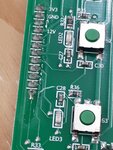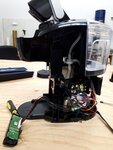nullsec
Newbie
Was disassembling my Keurig K-Compact K35 and I accidentally scratched the PCB with the buttons.
Intention of disassembly was to wire in a few relays to allow control of the buttons with a Raspberry PI.
Would it be easier (if at all possible) to remake the circuit on a breadboard for now so I can get my RPI project going or should I just try to bridge the trace?
I'm also wondering how one would figure out how to wire the relays into this, and how one would identify what signals are sent when the buttons are pressed. I was not thinking the buttons PCB would be so complicated. Not sure how I would wire a relay into this, even if the PCB was not scratched.
New to electronics, not experienced soldering, and have very unsteady hands. Let me know what additional information I can provide.
Any and all help appreciated.
Intention of disassembly was to wire in a few relays to allow control of the buttons with a Raspberry PI.
Would it be easier (if at all possible) to remake the circuit on a breadboard for now so I can get my RPI project going or should I just try to bridge the trace?
I'm also wondering how one would figure out how to wire the relays into this, and how one would identify what signals are sent when the buttons are pressed. I was not thinking the buttons PCB would be so complicated. Not sure how I would wire a relay into this, even if the PCB was not scratched.
New to electronics, not experienced soldering, and have very unsteady hands. Let me know what additional information I can provide.
Any and all help appreciated.


